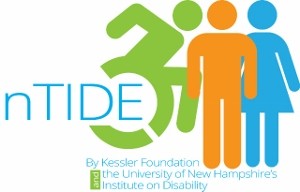
July 2, 2015
The National Trends in Disability Employment (nTIDE) has recently updated the statistics of individuals that are working with a disability. The Kessler foundation presents an article that describes the newest trends and also the increase of employment for people with disabilities. Below is just an excerpt from the Kessler foundation, describing these findings.
“While employment gaps still exist, Americans with disabilities are engaging in the workforce at a faster rate than Americans without disabilities, according to today’s National Trends in Disability Employment – Monthly Update (nTIDE), issued by Kessler Foundation and University of New Hampshire’s Institute on Disability (UNH-IOD). Strategies that boost employment for people with disabilities are being implemented across the nation. Faith communities, for example, are well positioned to connect people and employers within their congregations.
In the Bureau of Labor Statistics’ Jobs Report released Thursday, July 2, the employment-to-population ratio for working-age people with disabilities increased from 25.6 percent in July 2014 to 27.8 percent in July 2015 (up 8.6 percent; 2.2 percentage points). For working-age people without disabilities, the employment-to-population ratio also increased slightly from 72.2 percent in July 2014 to 72.7 percent in July 2015 (up 0.7 percent; 0.5 percentage points). The employment-to-population ratio, a key indicator, reflects the percentage of people who are working relative to the total population (the number of people working divided by the number of people in the total population multiplied by 100). In comparison to July 2014, 537,000 more Americans with disabilities are in the workforce.
“Over the past nine months, more Americans with disabilities are becoming employed relative to the same time last year,” according to John O’Neill, Ph.D., director of employment and disability research at Kessler Foundation. “These gains for people with disabilities continue to exceed gains made by people without disabilities. This is indeed good news as we prepare to celebrate the twenty-fifth anniversary of the Americans Disabilities Act.”
For people with disabilities, the labor force participation rate also increased from 29.9 percent in July 2014 to 31.0 percent in July 2015 (up 3.7 percent; 1.1 percentage points). For people without disabilities, the labor force participation rate decreased slightly from 76.9 percent in July 2014 to 76.8 percent in July 2015 (down 0.1 percent; 0.1 percentage points). The labor force participation rate is the percentage of the population that is working or actively looking for work.
“For so many years—decades—the growth in employment for people with disabilities has lagged well behind that of people without disabilities,” said Andrew J. Houtenville, Ph.D., associate professor of economics and research director at UNH-IOD. “With each month that we see continued positive news for people with disabilities, it makes me wonder whether we are seeing a real, long-term, structural shift in employment patterns—nine months is still a relatively short period of time, but it’s better than seeing the opposite trend.”
Networking with family and friends is a strategy that the majority of people with disabilities use successfully when preparing for work (62.4 percent) and while actively job hunting (68.1 percent), according to the recently released 2015 Kessler Foundation National Employment & Disability Survey. Initiatives that unite community organizations toward the goal of employment are broadening the scope of networking and expanding the opportunities to connect job seekers and employers. One such program is Putting Faith to Work, a program funded by Kessler Foundation that utilizes the networks of faith communities. The program’s lead site is the Vanderbilt Kennedy Center at Vanderbilt University.”
Continue reading about the new statistics found from nTIDE on Kessler Foundation.
